I first met Crispín García Méndez in Oaxaca in October 2019, when his son Rigo invited my partner Brooks and I to celebrate the saint’s day of San Dionisio. We only briefly visited the family palenque before heading out with bottles of mezcal to share with the calenda.
It was a wild day, and we found ourselves winding our way through the streets with what felt like the whole town. We saw dancing horses, while Brooks surprised the local children by singing (howling) in harmony with one of our dogs. I’m glad I have a photographic record, as it was a blur of color and endlessly full copitas.
Crispín García Méndez is the founder and producer of Geü Beez mezcal. Working with his sons Daniel and Rigo, Crispín grows and distills agave in the hills of San Dionisio, Ocotopec, about an hour-and-a half from Oaxaca City. Their goal is to create a truly sustainable mezcal.
Geü Beez is the Zapotec name for Río de Avispas (River of Bees/Wasps) which is the location of the first palenque in San Dionisio. Daniel explains that the brand was named “in honor of the mezcal masters who worked where the palenque is today.”



Almost exactly five years after my first visit to palenque Geü Beez, I was fortunate enough to have the honor to return–this time a little more clear-headed. On this trip, Brooks and I were traveling with Susan Coss of Mezcalistas. First, Crispín’s wife, Epifanía, treated us to a delicious breakfast in an alcove next to their mezcal store. Over memelas with spicy salsa, we caught up with Daniel and Rigo, before heading to the distillery.
Palenque Geü Beez is picturesque, up a track of lush foliage and nestled in the shade of ancient Sabino trees. As we arrive, the first thing we see is a sheltered pit oven, and to the left an area with wooden fermentation vats and a tahona. In the open-air palenque, two copper alembic stills lunge out of their concrete baths. The aroma of freshly cooked agave accented by wafts of fermentation guides us through the property.


Crispín starts us off with a mezcal while he talks us through his process. He explains that they never rush.
“Today all the processes to produce mezcal are accelerated,” he says. “Everything should be in its own time. Patience is what the land, plants, and humans need.”
He says that they only make a tapada (cook their agave) if the time is right and when there is enough fully mature agave. “We prepare everything very early for the tapada of maguey, a ritual in which my children and friends participate,” he says. “The maguey and its flavor dictate the maximum amount we can ask of the plant.”
His brand’s website goes as far as to state: “Our processes are so dedicated that we prefer that our mezcals are not used in cocktails, since they would lose the flavor notes that our drinks offer.”
Creating a more sustainable mezcal industry
Crispín leads us to the area behind the Geü Beez palenque to some remnants of what he explains was the first palenque in the town. Daniel re-joins us with two of his daughters, and they lead us to the stream that runs from the palenque down toward the town. On the hillside, he shows off his collection of agave, terraced on a steep incline, demonstrating their ability to fight erosion.
Daniel is extremely passionate about inspiring the next generation to contribute and make sound environmental choices. He is concerned that new mezcaleros are looking for short-term profit, rather than considering the long-term impacts on the environment.
“Older people support us deeply, since they are very concerned about environmental balance,” he explains. “The new generation of mezcaleros is involved in other things. What hurts me the most is not giving a place and respect to the older mezcal masters, because if it weren’t for them, mezcal would not continue to live.”
Daniel’s concern is certainly warranted. On one of our previous visits to San Dionisio, we were surprised to come across a scarily large mezcal distillery, with a 30 ton pit overseen by a relatively young mezcalero who was producing for several brands. A stark opposite end of the spectrum.
Daniel is working closely with his father and focusing on ways to make sure his work is sustainable, if not regenerating the environment. Rigo and Daniel are developing their own labels, and the family is also focusing on projects to sustain the surrounding nature and the wider communities of San Dionisio.
Crispín can be secure in saying, “I feel very happy to know that my children and grandchildren will continue the legacy that I leave them, as my father did with me, and to know that they will put effort into it.”
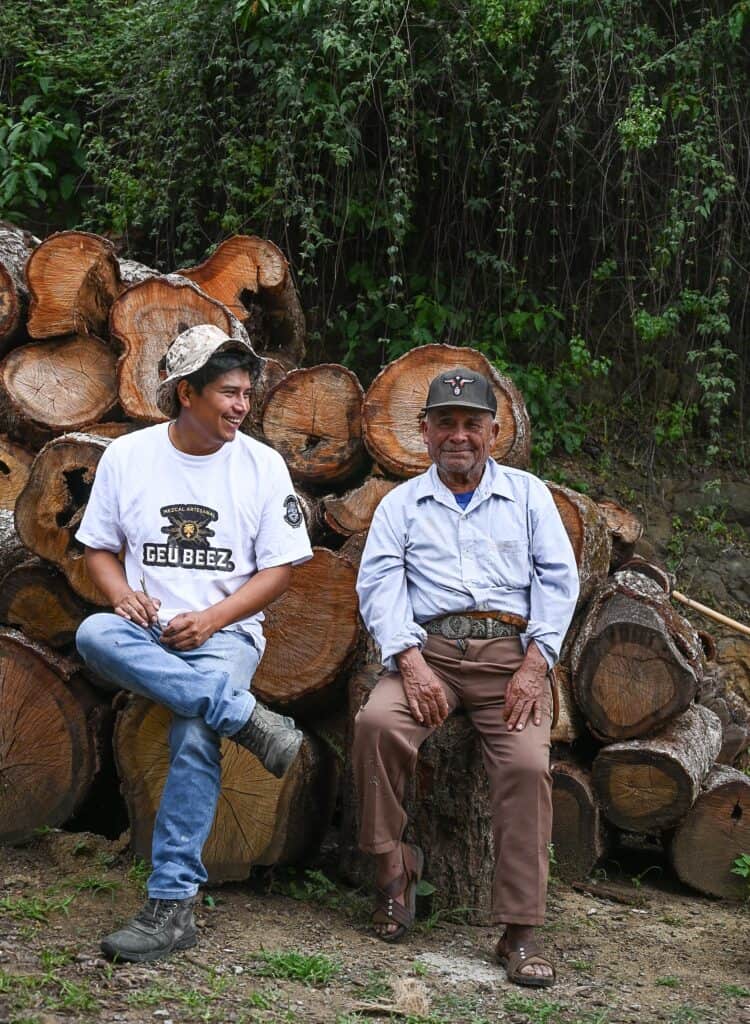

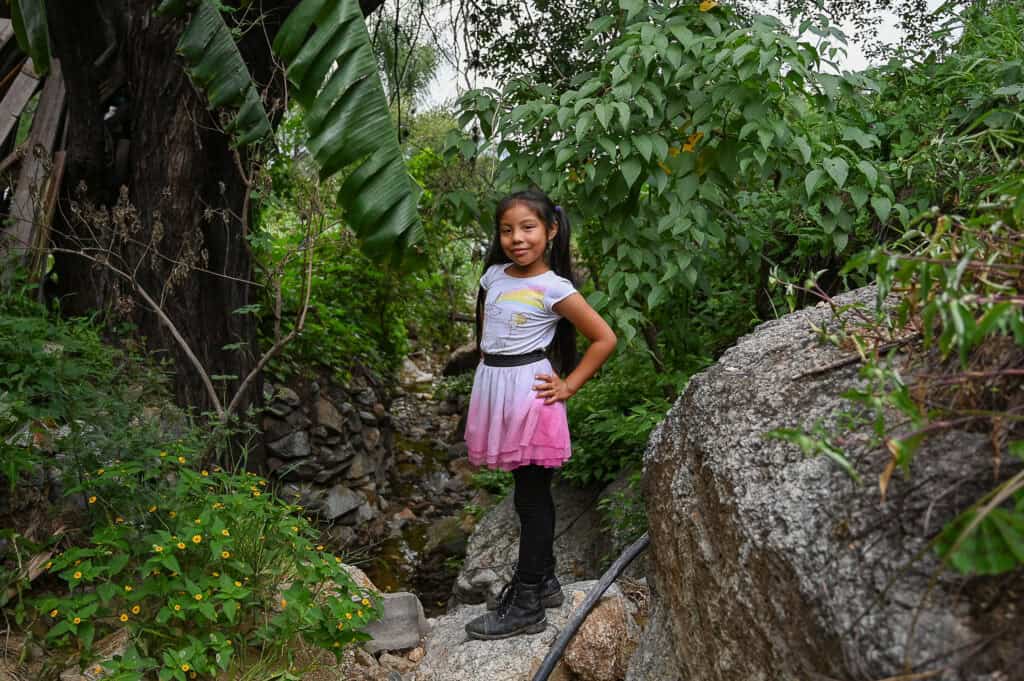
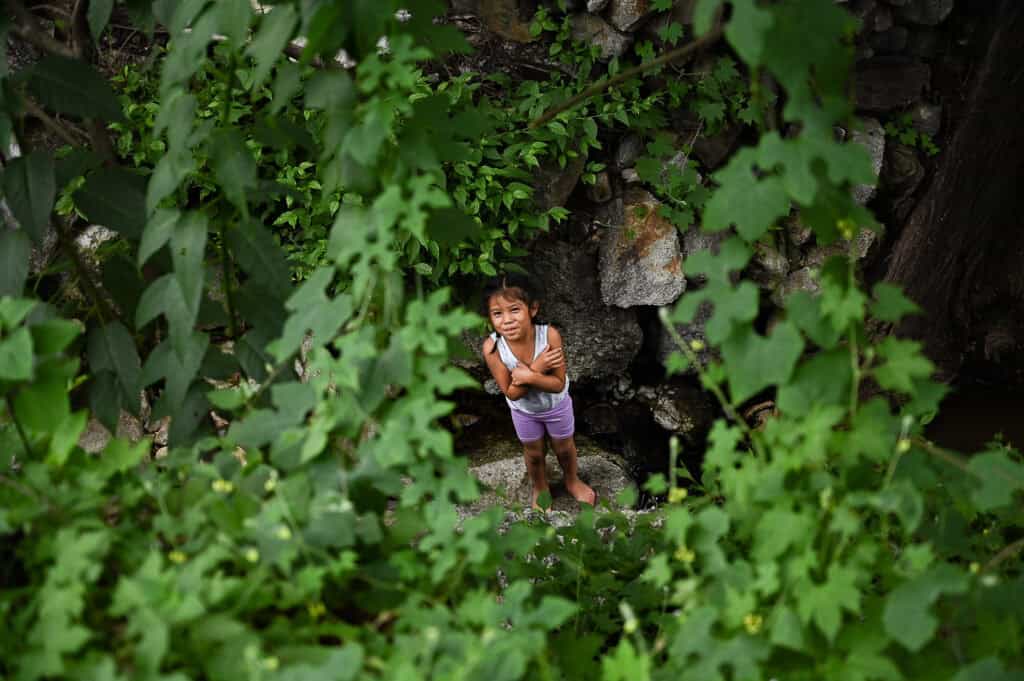
You can see how genuine Daniel is, thoughtfully sipping a mezcal while chatting in Zapotec with an old mezcalero who happens by. He emphasizes the need to preserve the connection to lessons and stories expressed in their indigenous language, as more generations lean to Spanish as their first language.
Truly sustainable mezcal means agave reforestation on a large scale
Although we could have all stopped and sipped mezcal at the Geü Beez palenque for hours, this trip was particularly aimed at visiting Daniel and Crispín’s new plantations of semi-cultivated tobalá maguey. This was no small feat, as the plants are way up in the mountains, beyond the reach of any vehicle.
We drove up out of San Dionisio several minutes before leaving the cars at the foot of the mountains by a reservoir, serenely overseen by a cow herder and her cattle. From there we began the hike, up through brush and trees, with Daniel’s daughters bounding about as if this was their normal route to school.
Trekking amongst native oak trees, cacti, and various others with only Zapotec names, they explain how wild tobalá used to cover these mountains. At points we were scrambling straight up – and tumbling down as well.
Eventually we made it to a ridge which we followed to clearings of magnificent tobalás. These agave won’t be harvested for producing mezcal. They will be left to live out their natural life-cycles and reproduce to help repopulate the mountainsides.

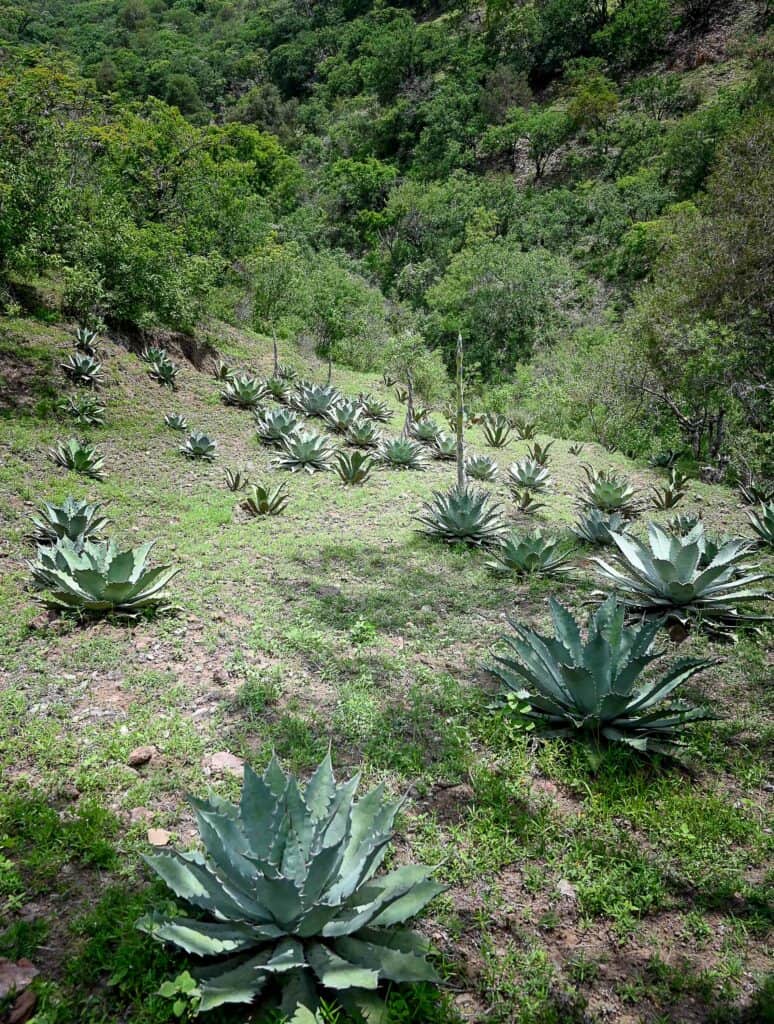
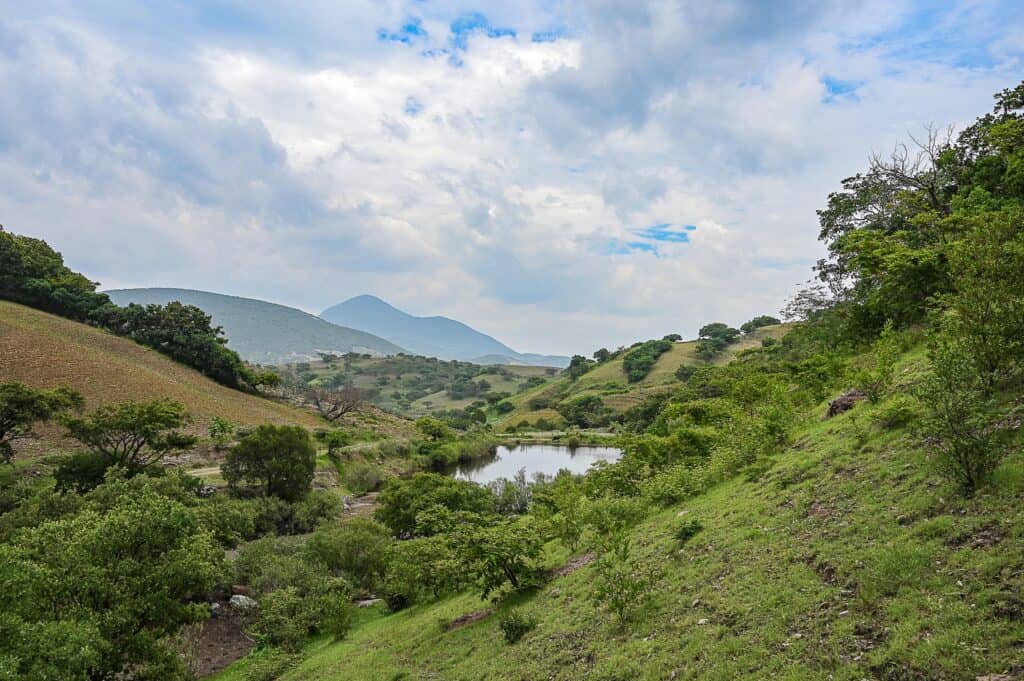
Daniel explains that their project is “long-term because of the time it takes for the magueys to grow.” The goal is to plant approximately 100,000 native magueys in their area and 200,000 trees in the next ten years.
“It’s important to plant wild agave and native trees in our hills,”Crispín says He explains that planting in the hills will help with water retention, filtering, and irrigation. “It is necessary for conservation purposes, to help the ecosystem.” He thinks people should be more conscious of “helping our planet in this way.”
In light of Oaxaca’s severe drought in recent years, and the many wildfires that ravaged these and the surrounding Sierras only a few months ago, projects like this are invaluable. However, these projects don’t come without challenges.
As well as paying workers for future harvests, Crispín hopes that the people of San Dionisio will be willing to volunteer help. It is possible that this work will fall under the notion of “tequio” in the community (collective work owed to the community).
Crispín is conscious that the work required to retrieve the plants may influence the final price of the mezcal. However, he considers that to be one of a myriad of factors that cause fluctuating prices in the mezcal market.
Discussing the ebb and flow of the market, Crispín talks about beginning work at a very young age, and having to work up in the mountains. The hardships he faced. When mezcal made you money and when it didn’t. He even touches on the cartels. His overall sentiment is that mezcal is his life, and he will keep making it no matter what comes his way.
He remembers that the most challenging times were the days when he could only harvest agave by burro (donkey). The itching from the juice of the cut plants and having his sandals burst.”
Animals are part of the family at Geü Beez
Crispín has a beautiful relationship with his animals. “For me they mean a lot. I teach them to work in a good way and so they help me in the work. They are very important to me because they are intelligent. They know who loves them and who does not.” He explains that without them he could not work. “I consider them as coworkers and part of my family.”

In addition to working with their father, Daniel and Rigo are both working on their own mezcal projects. Rigo produces Atila del Sur, while Daniel recently launched Almanauta.
Once we got down from the mountain, we stopped off at Daniel’s palenque, where he lives with his fiancee and three daughters. He has a great selection of mezcals stored in antique glass demijohns. Daniel has tobalá aging since March 2019 – he is saving it for his upcoming wedding!
The palenque has a gorgeous view toward San Dionisio, separated by the valley fields of milpas. Like his father, Daniel is keen to work with many different plants, to maintain biodiversity and healthy soil around his palenque. He hopes that his daughters will continue this legacy.
“I am very proud of my daughters, who at an early age are very focused on caring for the environment and are our motivation to continue with our projects, even though we do not have many resources to do so with greater impact.”



An bagazo recycling project that actually makes sense
Daniel is also working on a project of producing adobe blocks using the waste materials from the mezcal process. Although there are many producers experimenting with this upcycling of bagasse, Daniel has some innovative ideas, specifically to make the adobe blocks more durable using elements like nopal to bind it.
He explains that “This project is to avoid the contamination of rivers, wells and lands. We also seek to produce more adobe to help people who need it, and thus we seek the common good in our community.”
The family’s objective is to take their culture and mezcal to the whole world; to share the beautiful spirit they inherited. Daniel explains, “We recognize the impact that Mezcal has worldwide. That is why as Oaxacan producers we seek benefits for our communities by making a quality mezcal, with ethics and human values.”
These grassroots movements toward sustainable mezcal depend on the education and understanding of the older generations as well as the innovation and energy of the new generations. It takes the vision of hindsight to see how certain practices have affected the land and communities which they subsist on, to understand that taking care of the land is taking care of future generations. It is all so inspiring to see a group of people willing and able to do their part in ensuring a better future.
We are lucky enough to witness the beginnings of these projects. Seeing how much is already planted, it’s exciting to imagine these mountains ten years from now! However, we will be sure not to wait so long before our next visit!
I can’t wait to try the first mezcals eventually born of mountain tobalás we visited with Crispín and Daniel. If it’s anything like the wedding batch in Daniel’s palenque, it will be well worth the wait and appropriate price tag.
I also hope to have many more opportunities to join their family, celebrating in San Dionisio. They make great mezcal and they know how to share it!



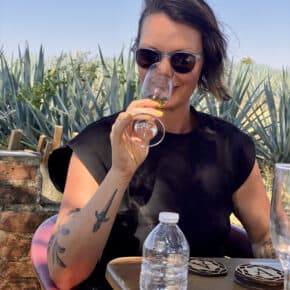


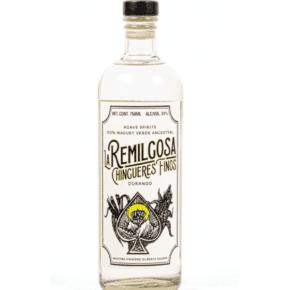








Leave a Comment